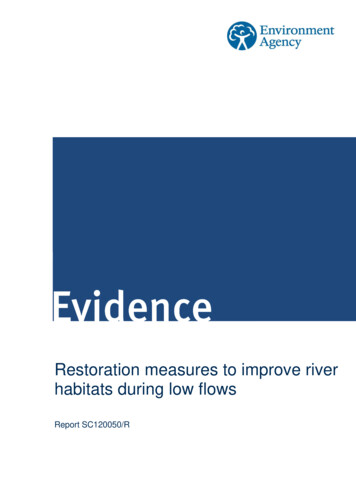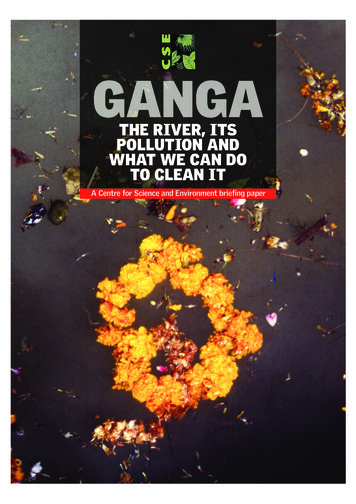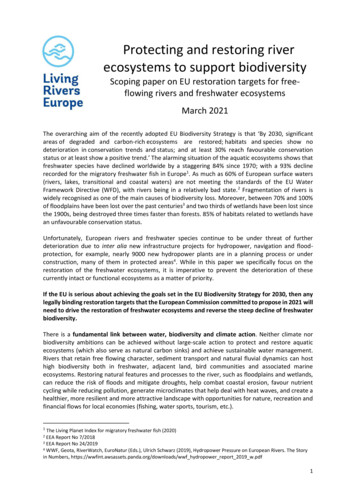
Transcription
Protecting and restoring riverecosystems to support biodiversityScoping paper on EU restoration targets for freeflowing rivers and freshwater ecosystemsMarch 2021The overarching aim of the recently adopted EU Biodiversity Strategy is that ‘By 2030, significantareas of degraded and carbon-rich ecosystems are restored; habitats and species show nodeterioration in conservation trends and status; and at least 30% reach favourable conservationstatus or at least show a positive trend.’ The alarming situation of the aquatic ecosystems shows thatfreshwater species have declined worldwide by a staggering 84% since 1970; with a 93% declinerecorded for the migratory freshwater fish in Europe1. As much as 60% of European surface waters(rivers, lakes, transitional and coastal waters) are not meeting the standards of the EU WaterFramework Directive (WFD), with rivers being in a relatively bad state.2 Fragmentation of rivers iswidely recognised as one of the main causes of biodiversity loss. Moreover, between 70% and 100%of floodplains have been lost over the past centuries3 and two thirds of wetlands have been lost sincethe 1900s, being destroyed three times faster than forests. 85% of habitats related to wetlands havean unfavourable conservation status.Unfortunately, European rivers and freshwater species continue to be under threat of furtherdeterioration due to inter alia new infrastructure projects for hydropower, navigation and floodprotection, for example, nearly 9000 new hydropower plants are in a planning process or underconstruction, many of them in protected areas4. While in this paper we specifically focus on therestoration of the freshwater ecosystems, it is imperative to prevent the deterioration of thesecurrently intact or functional ecosystems as a matter of priority.If the EU is serious about achieving the goals set in the EU Biodiversity Strategy for 2030, then anylegally binding restoration targets that the European Commission committed to propose in 2021 willneed to drive the restoration of freshwater ecosystems and reverse the steep decline of freshwaterbiodiversity.There is a fundamental link between water, biodiversity and climate action. Neither climate norbiodiversity ambitions can be achieved without large-scale action to protect and restore aquaticecosystems (which also serve as natural carbon sinks) and achieve sustainable water management.Rivers that retain free flowing character, sediment transport and natural fluvial dynamics can hosthigh biodiversity both in freshwater, adjacent land, bird communities and associated marineecosystems. Restoring natural features and processes to the river, such as floodplains and wetlands,can reduce the risk of floods and mitigate droughts, help combat coastal erosion, favour nutrientcycling while reducing pollution, generate microclimates that help deal with heat waves, and create ahealthier, more resilient and more attractive landscape with opportunities for nature, recreation andfinancial flows for local economies (fishing, water sports, tourism, etc.).1The Living Planet Index for migratory freshwater fish (2020)EEA Report No 7/20183 EEA Report No 24/20194 WWF, Geota, RiverWatch, EuroNatur (Eds.), Ulrich Schwarz (2019), Hydropower Pressure on European Rivers. The Storyin Numbers, https://wwfint.awsassets.panda.org/downloads/wwf hydropower report 2019 w.pdf21
This paper builds and complements the position paper ‘Restoring EU’s Nature’ released by a coalitionof 20 NGOs in October 2020. It presents elements to be considered as part of the new naturerestoration law specifically related to the protection and restoration of free-flowing rivers andfreshwater ecosystems. We consider these elements as essential to meet the key needs offreshwater ecosystems to allow their natural processes to sustain biodiversity values and to providekey ecosystem services. The legal requirements in the upcoming Nature Restoration Law need to beadded to existing obligations, in particular under the Birds Directive (BD), the Habitats Directive (HD),the Water Framework Directive (WFD) and the Marine Strategy Framework Directive (MSFD).The baseline level for protecting and restoring river ecosystems, is to meet the objectives of the WFD.The WFD requires Member States to meet standards for ecology, quality and quantity of waters toachieve ‘good status’ by 2027, however, river basin management will continue well beyond 2027.Unfortunately, we continue to witness widespread and ongoing deterioration of rivers, whichoutpaces restoration efforts given the current enabling conditions. This is due to insufficient ambitionof Member States in the implementation of the WFD, among other things.5 Some Member States arevery remote from correctly implementing the WFD and fully benefiting from its opportunities, bothin terms of preventing deterioration as well as implementing restoration measures in order toachieve the environmental objectives. Thus, any additional legislation for nature restoration agreedby the EU needs to be additional to the existing obligations under the WFD and combined withbetter implementation and enforcement of the existing legislation.Within the framework of "Restoring EU's Nature" we would like to make the followingrecommendations in relation to the freshwater ecosystems:Our 10 key recommendations and asks are:1. We recommend increasing the current target for free-flowing rivers of at least 25,000 kmto 15% of all rivers to be restored to a free-flowing state by 2030 through inter alia barrierremoval and floodplain restoration.2. The upcoming Nature Restoration Law should have a specific focus on how the targets willaddress the hydromorphological elements of aquatic ecosystems and their functionality.3. Restoration targets for freshwater ecosystems set in the upcoming Nature Restoration Lawshould focus on basin-scale restoration of river continuity to ensure better integration ofthe WFD and BHD implementation as well as targets to restore lateral connectivity throughrestoration of floodplains and wetlands.4. We recommend the development of binding targets for restoration of wetlands andinterconnected (small) waterbodies with high biodiversity or biodiversity potential,currently not addressed in the implementation of the WFD and HD. If added, they wouldbuild a more coherent, functional and lasting “green-blue infrastructure” network.5. To increase investment in river restoration actions, we recommend earmarking funds tomeasures directed specifically to restoration needs of freshwater ecosystems. This shouldbe done through: Using opportunities in the existing financial structures (e.g. EU CommonAgricultural Policy and related funds, European Structural and Investment Funds,Next Generation EU); Adding new funding mechanisms (such as blended instruments or insuranceindustry funding) and the creation of a dedicated EU restoration fund (or facilitywithin some other fund) in the MFF.5SWD(2019) 439 final COMMISSION STAFF WORKING DOCUMENT FITNESS CHECK of the Water Framework Directive,Groundwater Directive, Environmental Quality Standards Directive and Floods Directive.2
6. A “nature-based solution” requirement should be introduced to EU funds earmarked forinvestments in water, climate, disaster risk reduction, energy, agricultural and transportsectors, so that only interventions which both address societal challenges and preserve orimprove biodiversity conservation can benefit from public funds. Under the upcomingNature Restoration Law, river and wetland restoration measures and other nature-basedsolutions (NbS) which maintain and improve biodiversity whilst providing societal benefitsshould be given priority over single-objective solutions (such as grey infrastructure) towater-related problems.7. Targets for river restoration should include effective management post-restoration toensure the restored river systems maintain the environmental processes needed to meetthe project goals, such as the occurrence of target species and habitats. This is especiallyrelevant for anthropogenically modified rivers where periodic human intervention may benecessary for (re)creating optimal habitat characteristics.8. The WFD and HD provide a good basis for monitoring. In addition to this, the upcomingNature Restoration Law should require long-term monitoring programmes of the importantfreshwater key ecological attributes and biodiversity variables of holistic functioningriverine systems.9. The upcoming Nature Restoration Law should include a requirement that restored and freeflowing rivers also will be protected and kept in their free-flowing status. They should beintegrated (added) to the 30% of legally protected land area target proposed in theBiodiversity Strategy for 2030.10. We recommend that the European Commission creates a “dashboard” system, in which theprogress towards both no deterioration of current state as well as the target for freeflowing rivers can be monitored and publicly communicated.River restorationRiver restoration refers to ecological, hydromorphological, physical, spatial, and managementmeasures and practices aimed at restoring a functioning river system in support of native biodiversityand key ecosystem services, such as flood and drought risk mitigation, aquifer recharge, nutrientretention, and recreation. River restoration needs to be an integral part of river basin managementand directly supports the objectives of the WFD, BD, HD, Floods Directive. It also helps achieve theobjectives of the EU Biodiversity Strategy for 2030 and the EU Strategy on Adaptation to ClimateChange.The current gap in reaching Good Ecological Status in rivers shows the imbalance between the largescale of the problem for rivers, failure to prevent further deterioration and the small scale ofrestoration efforts implemented by Member States so far. Interventions have worked at local scale,but generally not at water body or full river basin scale where more efforts are needed. To overcomethis gap, we need: An intersectoral approach between water management and conservation authorities as well asother sectors which address spatial and land use planning. A large shift in funding to get restoration projects implemented. Funding should shift from singlepurpose solutions – often working against nature - to multi-purpose and broader geographicsolutions benefiting nature. More attention given to the catchment approach, because restoring a local site does not addresssystemic problems that often originate and accumulate from pressures from up or downstreamin the river network. More guidance, including example plans and demonstrations of successful restoration projects,and training programs to build capacity and increase knowledge.3
The goal should be to create and protect longer interconnected networks that are free-flowing andavoiding disjunct projects that don’t accumulate ecologically-meaningful kilometres of habitat.Setting legally binding targets to restore free flowing riversA very large share of Europe's large rivers are no longer free flowing (Figure 1).6 Therefore, settinglegally binding targets to restore rivers to free flowing state and add a layer of lasting protection isneeded. This needs to be supported by integrated planning, guidance and funding to meet the goalsof the EU Biodiversity Strategy to restore at least 25,000 km of free-flowing rivers by 2030 through theremoval of primarily obsolete barriers and the restoration of floodplains and wetlands.Figure 1: Free flowing and fragmented river networks in Europe, Source: EEA, 2020In addition, several elements suggest that this target needs to be increased: The goal of 25,000 km of rivers returned to free flowing state would represent only around 2% ofEuropean rivers.7 There is no overall assessment of the free flowing state of small rivers, butindications may be found at national level. For example, in the UK, less than 1% of catchments are6EEA (2020). Floodplains: a natural system to preserve and restore. EEA Report No 24/2019According to the WISE database, river bodies (excluding UK and Norway) amount to 1,186,695 km. teronline/views/WISE SOW SurfaceWaterBody/SWB NumberSize?:embed y&:showShareOptions true&:display count no&:showVizHome no74
free of artificial barriers.8 In Spain and Portugal, estimations of existing obstacles in rivers arerespectively 50,000 and 8,000.9The AMBER project concluded that more than 10% of the 1 million barriers recorded in Europeare abandoned or obsolete, which means that there may be over 100,000 obsolete barriers thatcould be removed to help reconnect Europe’s rivers. By acting on only 2.5% of these, 25,000 kmtarget could be reached10, so that is indeed only the beginning of what’s needed.The last State of Nature in the EU report shows that 10.5% of protected freshwater habitats (about13 500 km2) and 9% of Europe’s wetlands (protected bogs, mires and fens habitats about 10 900km2) need restoration or improved management, and that 1700 km2 of bogs, mires and fens needto be (re)created to add to the existing protected area in order to ensure the long-term viabilityof all habitat types.11Many rivers in Europe are heavily fragmented by dams, weirs, and road crossings, so they aretransformed into chains of impoundments, leaving behind only small and short relicts of formerlydynamic rivers, not enough to conserve species, habitats, and most importantly the necessaryprocesses that support them. To preserve and restore European river species and habitats therestoration of impounded river sections should refocus on restoration to increase free-flowingsections in larger rivers and key tributaries to restore the main axes of European river corridorsand priority connected networks of a diversity of sizes, with the emphasis on large connectednetworks. There is a need for both better connections among headwaters and for migratory fishin larger river systems that connect to the sea.Based on the above estimates, we recommend increasing this goal to achieve at least 15% of allrivers to be restored to a free-flowing state by 2030 through inter alia barrier removal and floodplainrestoration.For this paper we use the following definition of free-flowing rivers: "Free-flowing rivers are riverswhere ecosystem functions and services are largely unaffected by changes to the fluvial connectivity,allowing unobstructed movement and exchange of water, energy, material and species within theriver system and with surrounding landscapes. Fluvial connectivity encompasses longitudinal (riverchannel), lateral (floodplains), vertical (groundwater) and temporal components. It can becompromised by (i) physical infrastructure in the river channel, along riparian zones or in adjacentfloodplains; and (ii) hydrological alterations of river flow due to water abstractions or regulation”.12,13Additional guidance is needed to prioritize those kilometres to places with existing, or with thepotential for restoring at a large-enough scale, outstanding biodiversity and climate mitigation andadaptation potential. We recommend for the European Commission to use the above-mentioneddefinition of free-flowing rivers, which suggests that not only obstacles to longitudinal connectivityshould be removed, but also the lateral connectivity should be restored. The prioritisation shouldconsider the reconnection potential, i.e. the potential for a barrier removal to reconnect not only two8EEA Report No 24/2019Centro Ibérico de Restauración Fluvial (CIREF). 2017. Criteria for decision-making towards the improvement of riverconnectivity and dam removal considering the impacts of invasive fish species in the Iberian Peninsula. Technical reportdeveloped by D. Miguélez Carbajo, León, Spain. https://europe.wetlands.org/download/3016/10 /11REPORT FROM THE COMMISSION TO THE EUROPEAN PARLIAMENT, THE COUNCIL AND THE EUROPEAN ECONOMIC ANDSOCIAL COMMITTEE. The state of nature in the European Union Report on the status and trends in 2013 - 2018 of speciesand habitat types protected by the Birds and Habitats Directives ?uri CELEX:52020DC0635&from EN page 16.12 In addition, longitudinal continuity for fauna can be affected by changes to water quality that lead to ecological barriereffects caused by pollution or alterations in water temperature.13 Grill, G., Lehner, B., Thieme, M. et al. Mapping the world’s free-flowing rivers. Nature 569, 215–221 (2019).https://doi.org/10.1038/s41586-019-1111-995
sections of the river channel, but also the river with its surrounding floodplains, riparian zones orwetlands. In this regard, the ecological quality of the reconnection should also be considered,including the length of reconnected river, the natural habitats which can be reconnected, the potentialfor reconnecting the riparian zone, the protection status of the reconnected river stretch as well asthe position of the barrier inside protected areas.14Care in prioritisations of basins or stream networks for restoration is critical, not only to focusrestoration to the most valuable habitats, but also to avoid potential situations where the WFD andHD objectives are at cross-purposes. For example, this might happen when restoring water bodies toachieve Good Ecological Condition under the WFD causes the loss of Natura 2000 habitats or specieswhich have developed in an artificially modified or managed environment (e.g. reconnection ofoxbows lakes).Focus on hydromorphological restorationThe upcoming Nature Restoration Law should have a specific focus on how the targets will addressthe hydromorphological elements of aquatic ecosystems and their functionality. Hydrologicalconnectivity is essential for maintaining freshwater biodiversity.15 Hydromorphological processesdrive longitudinal, lateral and vertical connectivity within river networks and surrounding corridors,the assemblage and turnover of habitats, the movement of sediment and structures, and theecosystems associated with the diverse mosaic of continuously changing habitats. All of theseprocesses and structures are relevant to ensuring that robust, enduring habitats can support the entirelife cycle of organisms including refugia, feeding and spawning.16Despite the fact that natural hydromorphological dynamics are fundamental in supporting ecosystemfunction and quality, hydromorphological elements are generally not fully considered in theapplication of the WFD classification system of water bodies. This can potentially lead to furthermodifications and deterioration.17 For instance, conditions for the three hydromorphological qualityelements (hydrological regime, river continuity and morphological conditions) are only specified forHigh status, but not for Good and Moderate Status. A wider consideration of the needed functioningof hydromorphological elements under the future Nature Restoration Law would enhance theability of Member States to conserve and restore water bodies.14WWF is working on a study using those parameters, expected in Q2 2021.Other prioritisation tools include: TNC: an interactive, GIS based decision support tool using a large set of data (morphology, infrastructure, biotic, etc.)which can be queried for various outcomes (cost effectiveness, biodiversity impact, interventions for target speciesimprovement). While it has been used in the USA for many years, it is currently being field tested in two watersheds inSlovenia to illustrate how the tool can be applied in Europe. It will be ready for demonstration in Q2 2021. BOKU University (Vienna): a prioritization tool/multicriteria analysis (FEM- Floodplain Evaluation Matrix) usingdifferent type of hydrological, hydraulic, socio-economic and biodiversity parameters.15 Van Rees, C.B. e.a. (2020). Safeguarding Freshwater Life Beyond 2020: Recommendations for the New Global BiodiversityFramework from the European Experience. Preprints 2020, 2020010212 (doi: 10.20944/preprints202001.0212.v1).16 A.M. Gurnell, e.a. (2014) A hierarchical multi-scale framework and indicators of hydromorphological processes andforms. Deliverable 2.1, a report in four parts of REFORM (REstoring rivers FOR effective catchment Management), aCollaborative project (large-scale integrating project) funded by the European Commission within the 7th FrameworkProgramme under Grant Agreement .1%20Part%201%20Main%20Report%20FINAL.pdf17 Nones, Michael (2015). Sediment management of rivers and water framework directive: the case of the spree river. Eproceedings of the 36th IAHR World Congress, 28 June – 3 July, 2015, The Hague, the on/280306278 Sediment management of rivers and Water Framework Directive the case of the Spree River6
Large-scale restoration of longitudinal and lateral continuity for hydrologic and sediment transportand mitigation of hydrological alteration can help improve the link between the (local) conservationof Natura 2000 freshwater sites and catchment scale processes (e.g. hydropeaking, sediment deficit,lack of morphologically active floods). The hydromorphological character of river reaches depends notonly on interventions and processes within the reach but also within the upstream and sometimes thedownstream catchment (which may cross the national boundaries).18 However, pressures fromupstream are often outside the sphere of control of the management authority and may happenwithin water bodies that are in Good Ecological Status, meaning that strictly speaking, the relevantauthorities do not have to intervene or may find it challenging to justify the investment. Proper riverbasin management planning should address such situations, but in practice the preservation of wholeconnected systems of habitats and species under the HD is hampered.Growing scientific knowledge indicates that the natural hydromorphological systems are generallymore resilient to sudden events and have faster recovery so approximation of natural conditionsthrough restoration is a win-win situation i.e. for flood protection and biodiversity.Restoration targets for freshwater ecosystems set in the upcoming Nature Restoration Law shouldfocus on basin-scale restoration of river continuity to ensure better integration of the WFD and HDimplementation as well as targets to restore lateral connectivity through restoration of floodplainsand wetlands.Restoration of water bodies not addressed in the implementation of the WFD and HDAlthough the WFD aims to protect, enhance and restore all bodies of surface water, itsimplementation is focused on the designation of water bodies i.a. based on the size of the catchmentarea, only considering the largest rivers (catchment 10km2) and lakes ( 0.5 km2 surface area).19 Otherwater bodies, especially small lakes, ponds, headwater streams, temporal or ephemeral rivers,floodplains, and ditch systems are largely excluded despite the fact that they provide some of themost important, abundant and diverse aquatic habitats.In its Resolution 2020/2613(RSP) on the Implementation of the Water Legislation, the EuropeanParliament “[c]all[ed] on the Commission and the Member States to enhance the synergies betweenwater and biodiversity policies by introducing appropriate measures to better protect small waterbodies and groundwater [dependent] ecosystems in the context of river basin management, includingreporting requirements, guidance and projects”.20The HD protects small standing and running waters but relies on other mechanisms for dealing withmajor catchment pressures (e.g., diffuse pollution)21 while the provisions of its Article 10 are poorlyimplemented and enforced. Moreover, small water bodies are insufficiently represented in the Natura2000 network.22For example, the presence of standing waters in floodplains (backwaters and ponds) significantlyenhances biodiversity in the system but is overlooked in existing legislation and/or its implementation.To improve bioindicators outside the channel, the entire functional river–floodplain ecosystem needs18A.M. Gurnell, e.a. (2014) – see footnote 7.Water Framework Directive, annex II.20 Paragraph 39, -2020-0377 EN.html21 Sayer, C.D. (2014). Conservation of aquatic landscapes: ponds, lakes, and rivers as integrated systems. WIREs Water2014, 1:573–585. doi: 10.1002/wat2.104522 Paragraph 5.3, EEA (2020). State of nature in the EU, Results from reporting under the nature directives 2013-2018. EEAreport No 10/2020.197
to be considered. Restoration activities need to cover not just the stream itself but also adjacentwetlands, headwaters and riparian habitats. Moreover, protection, restoration, and appropriatemanagement of headwater areas with networks of (farmland) ponds, ditches, and small streamsshould increase connectivity for native aquatic species, while providing benefits downstream in termsof flood attenuation and water quality improvement.23Groundwater is interacting with rivers, streams, wetlands and springs, and is an important element ofthe water and river ecosystem network in the landscape. The exchange of water between rivers,streams, floodplains, and groundwater bodies is essential in the river corridors, connecting aquaticand terrestrial habitats. However, the groundwater bodies under the WFD are often too big to preventdeterioration of groundwater-dependant species and habitats.Disconnection from riverine landscapes, straightening, damming, hydro-peaking from damoperations, and gravel extraction accompanied by agricultural and sewage nutrients, pesticides, andinvasive species further exacerbate river degradation in many European regions. Each impact causesproblems for river ecology and biodiversity, and our human benefits; all together it means our riversneed enormous ambition and resources to be restored and then protected.Restoration activities need to focus on all of the freshwater habitats in the landscape, includinggroundwater bodies and on the linkages between them and surface waters, following an integratedapproach. Therefore, we recommend the development of binding targets for restoration of wetlandsand interconnected (small) water bodies with high biodiversity or biodiversity potential, currentlyoutside the implementation of the WFD and HD. If added, they would build a more coherent,functional and lasting “green-blue infrastructure” network.Integrated and nature-based solutions and green-blue infrastructure along riversCurrent investments in water solutions are strongly related with grey infrastructure such as dikes anddams as part of infrastructure projects serving only one sectoral objective. They often have significantnegative impacts on freshwater ecosystems, including accumulated impact from several hydropowerplants or other infrastructure in the same catchment. To increase coherence between the WFD, theFloods Directive, Biodiversity Strategy and other sectoral policies such as climate change adaptation,agriculture and spatial planning, Member States should apply integrated river restoration measureswhich can both improve the ecological functioning and biodiversity status of water bodies and addressthe objectives of multiple policies. These measures and other types of NbS can play a central role inmainstreaming biodiversity across sectoral policies, as they benefit and are based on biodiversity,while also delivering multiple wider societal, environmental and economic benefits. Therefore, theirfull potential should be tapped to contribute to the EU Biodiversity Strategy to 2030.24 Examples andguidelines of NbS in river restoration have been developed and are ready for practical use in manyEuropean rivers and streams.25 Unfortunately, in the majority of Member States there is a deficiencyin the adoption of NbS.2623Sayer, C.D. (2014). Conservation of aquatic landscapes: ponds, lakes, and rivers as integrated systems. WIREs Water2014, 1:573–585. doi: 10.1002/wat2.104524 Sandra Naumann and McKenna Davis (2020). Biodiversity and Nature-based Solutions, Analysis of EU-funded projects.European Commission, Directorate-General for Research and ased-solutions.pdf25 See e.g. IUCN National Committee United Kingdom, Stephen Ally et al., River Restoration and Biodiversity. Nature-BasedSolutions for Restoring the Rivers of the UK and the Republic of Ireland; Georg Hermannsdorfer (2020), Renaturierung vonFließgewässern: Praxishandbuch für naturnahe Bauweisen; Heinz Patt (2018), Naturnaher Wasserbau: Enwickeln undGestalten von Fließgewässern26 Wetlands International (2020), Time for a new recipe for flood risk management in Europe.https://europe.wetlands.org/download/4684/8
Rivers in Europe are most important corridors for biodiversity and for many migratory species. Largefree-flowing rivers should be the backbones of green-blue infrastructure in Europe. With the river asa dynamic connecting lifeline in the centre, ecological river corridors are able to not only connectlandscapes as a linear element from source to sea but should be broad enough and contain diverseterrestrial ecosystems at its margins to be functional and flexible, while also protecting people andsome habitats from floods whilst enabling habitat connectivity in and around settlements and citieswhere communities have some of their most important connections to nature.Restoring connectivity and habitats in mainstream and tributary rivers should be a priority forrestoration of key long-distance and most endangered fish species. The measures to conserve theEuropean eel and the Pan-European Action Plan for Sturgeons27 are important elements to savemigratory fish species and should be fully implemented to support the achievement of the targets inthe European Biodiversi
Within the framework of "Restoring EU's Nature" we would like to make the following recommendations in relation to the freshwater ecosystems: Our 10 key recommendations and asks are: 1. We recommend increasing the current target for free -flowing rivers of at least 25,000 km . Figure 1: Free flowing and fragmented river networks in Europe .
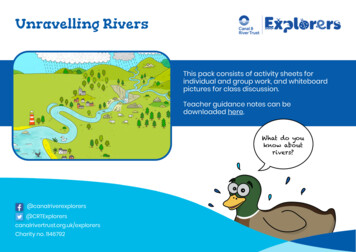
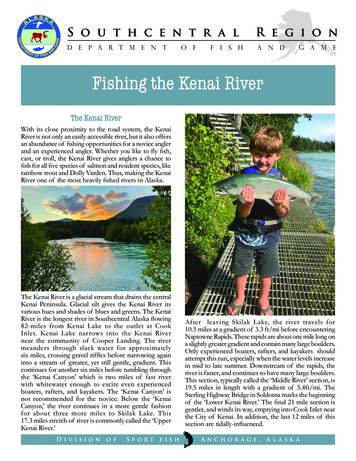
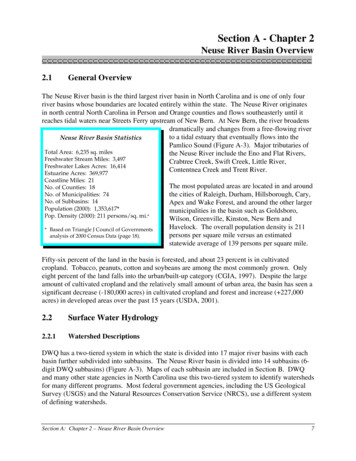
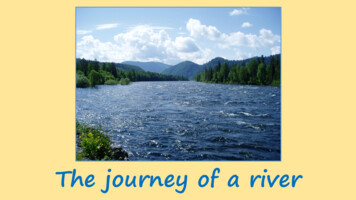
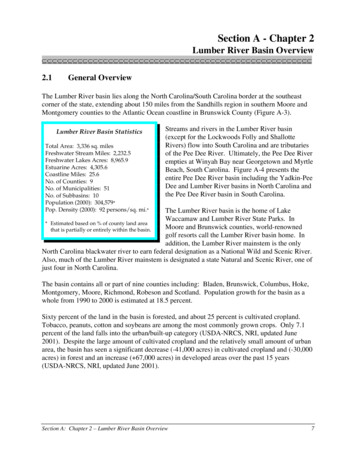
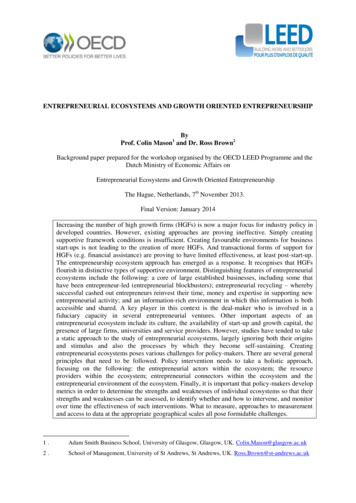

![Ecosystems 5E Lesson Plan for Grades 3-5 [PDF]](/img/22/ecosystems-lesson-plan-gg.jpg)
